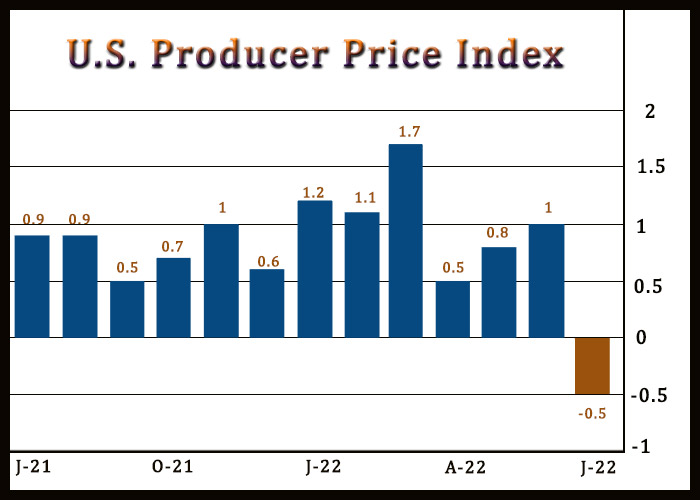U.S. Producer Prices Unexpectedly Decrease For First Time Since April 2020
After yesterday’s report showing U.S. consumer prices came in flat in the month of July, the Labor Department released a separate report on Thursday showing producer prices unexpectedly decreased during the month.
The Labor Department said its producer price index for final demand fell by 0.5 percent in July after surging by a revised 1.0 percent in June.
The pullback came as a surprise to economists, who had expected producer prices to edge up by 0.2 percent compared to the 1.1 percent jump originally reported for the previous month.
The unexpected decrease in producer producers, which marked the first drop since April 2020, largely reflected a sharp pullback in energy prices.
Energy prices plunged by 9.0 percent in July after soaring by 9.4 percent in June, with a 16.7 percent nosedive in gasoline prices leading the downturn.
The report also showed the annual rate of producer price growth slowed to 9.8 percent in July from 11.3 percent in June. Economists had expected the annual rate of growth to slow to 10.4 percent.
Meanwhile, the Labor Department said core producer prices, which exclude prices for food, energy and trade services, crept up by 0.2 percent in July after rising by 0.3 percent in June.
The annual rate of core producer price growth also slowed to 5.8 percent in July from 6.4 percent in the previous month.
The report also showed prices for services inched up by 0.1 percent in July following a 0.3 percent increase in June.
Prices for transportation and warehousing services climbed by 0.4 percent, prices for trade services rose by 0.3 percent and prices for other services ticked up by 0.1 percent.
“A potential peak in annual inflation measures is a welcome sign for both consumers, businesses, and the FOMC, but historically elevated price dynamics churning in the economy will likely persist through the end of the year,” said Mahir Rasheed, U.S. Economist at Oxford Economics.
He added, “However, with the Fed remaining laser-focused on tightening policy to restrict inflation pressures, producer price inflation will downshift significantly in 2023 as economic activity slows in response to more moderate demand from consumers.”
On Wednesday, the Labor Department released a separate report showing U.S. consumer prices came in flat in the month of July, with a sharp pullback in gasoline prices offsetting higher prices for food and shelter.
The Labor Department said its consumer price index was unchanged in July after jumping by 1.3 percent in June. Economists had expected consumer prices to edge up by 0.2 percent.
Compared to the same month a year ago, consumer prices in July were up by 8.5 percent, reflecting a bigger than expected slowdown from the 9.1 percent spike in June.
The annual rate of price growth was expected to slow to 8.7 percent from the four-decade high seen in the previous month.
Meanwhile, the report said core consumer prices, which exclude food and energy prices, rose by 0.3 percent in July after climbing by 0.7 percent in June. Core prices were expected to increase by 0.5 percent.
The annual rate of core consumer price growth was unchanged at 5.9 percent, while economists had expected an acceleration to 6.1 percent.
Source: Read Full Article

